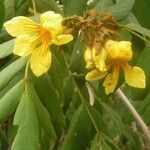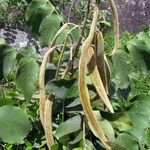Leaves 18–56 cm. long (1)3–5(6)-jugate, inferior pairs smaller, pseudostipules 0.5–1.3 cm. long, subulate-acuminate, tomentose; petiole 2–9.5 cm. long; leaflet-lamina (4.5)6.5–5.17(23) × 2.5–9.5(13.5) cm.; elliptic to oblong, ovate or obovate, sessile, apex obtuse to rounded, sometimes acute to shortly acuminate, rarely longly acuminate, base obtuse, rounded to subcordate, sometimes asymmetric margins entire or rarely thinly serrate pubescent to puberulous on the superior surface, densely woolly on the inferior; lateral nerves (6)7–12(14).
Corolla bright yellow, funnel-shaped to campanulate; lobes spreading, subcircular, 1.7–3 cm. in diam., the 3 lower ones streaked brown-reddish and with conspicuous glands near the mouth of the 2.5–4.5 cm. long corolla tube.
Capsule 20.84 x 1.8–2.5 cm., falciform to nearly straight, flattened, velvety tomentose with golden soft hairs, valves with a prominent longitudinally median ridge and two marginal ones near the dehiscing lines.
Inflorescence a dense and tomentose terminal, many-flowered densely branched panicle 10–30(40) cm. long; pedicels 1–2.3(2.8) cm. long; bracts 0.5–1(1.5) cm. long.
Stamen-filaments 1.5–2 cm. long, pilose at the bass, adnate to the corolla tube up to c. 1 cm. from the base; anther-thecae 2.3–3.5 mm. long, divergent.
Calyx 1.9–3.3 × 1.5–2.5 cm. obtusely cuspidate or uncinate, fissuring down to 4–8 mm. from the base, densely tomentose with golden hairs.
Bark light brown to grey, smooth to somewhat striated in large specimens.
Branchlets velvety tomentose with golden brown hairs, soon glabrescent.
Bushy shrub up to 1.5–5 m. or small tree 5–15 m. high.
Disk 2 mm. long and 4–5 mm. in diam., cupuliform.
Seeds 0.7–1.2 x 3.36 cm. including the wing.
Ovary 5–8 mm. long; style 17–27 mm. long.



